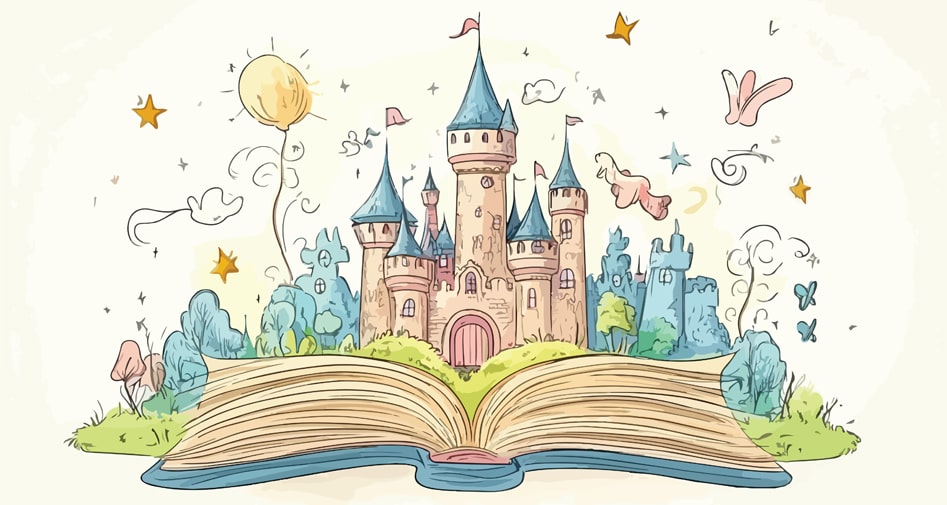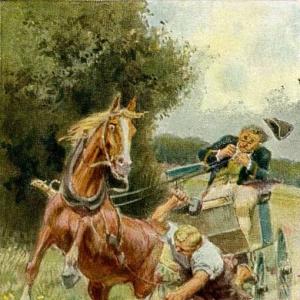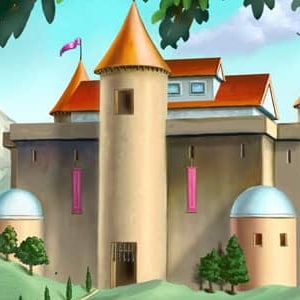Reading time: 4 min
„Yes, this is a song for very small children!“ declared Aunt Malle. „As much as I should like to, I cannot follow this ‚Dance, Dance, Doll of Mine!'“ But little Amalie could. She was only three years old, played with dolls, and brought them up to be just as wise as Aunt Malle.
There was a student who came to the house to help her brothers with their lessons, and he frequently spoke to little Amalie and her dolls. He spoke differently from anyone else, and the little girl found him very amusing, although Aunt Malle said he didn’t know how to converse with children – their little heads couldn’t possibly grasp that silly talk. But little Amalie did.
Yes, the student even taught her the whole song, „Dance, Dance, Doll of Mine!“ and she sang it to her three dolls. Two were new, one a girl doll and the other a boy doll, but the third doll was old. Her name was Lise-moér. She also heard the song, and was even in it.
Dance, dance, doll of mine!
Girl doll’s dress is very fine.
Boy doll is a dandy, too.
He wears gloves and hat and shoe.
White pants, blue coat, him adorn.
On his toe he has a corn.
He is fine and she is fine.
Dance, dance, doll of mine!Old doll’s name is Lise-moér.
She is from the year before.
Hair is new, it’s made of flax,
Forehead polished up with wax.
Young again, not old and done.
Come along, my cherished one,
Let us dance a fast gavotte.
To watch it is worth a lot.Dance, dance, doll of mine!
Watch your steps and get in line.
One foot forward, watch your feet.
Dancing makes you slender, sweet.
Bow and twist and turn around.
That will make you hale and sound.
What a sight it is to see!
You are doing fine, all three.
And the dolls understood the song. Little Amalie understood it, and so did the student, but then he had written it himself and said it was excellent. Only Aunt Malle didn’t understand it. She had passed over the fence of youth. „Silly song!“ she said. But not little Amalie! She sings it. It is from her that we know it.
 Learn languages. Double-tap on a word.Learn languages in context with Childstories.org and Deepl.com.
Learn languages. Double-tap on a word.Learn languages in context with Childstories.org and Deepl.com.Backgrounds
Interpretations
Adaptions
Summary
Linguistics
„Dance, dance, doll of mine!“ is a lesser-known fairy tale by Hans Christian Andersen, a Danish author best known for his classic children’s stories. Born on April 2, 1805, in Odense, Denmark, Andersen grew up in a poor family and experienced many hardships in his early life. Despite his humble beginnings, Andersen pursued his passion for writing and eventually became a successful author.
Andersen is best known for his fairy tales, which have been translated into more than 125 languages and enjoyed by children and adults alike. His stories often contain moral lessons and universal themes that resonate with readers across generations. Some of his most famous works include „The Little Mermaid,“ „The Ugly Duckling,“ „The Emperor’s New Clothes,“ and „The Snow Queen.“
„Dance, dance, doll of mine!“ is a charming story that showcases the innocence and wonder of childhood, the power of imagination, and the beauty of simplicity. Like many of Andersen’s tales, it features a blend of realism and fantasy, engaging readers with its vivid characters and captivating narrative. The tale was written during a period when Andersen was creating many stories that explored various themes and issues relevant to his time. In „Dance, Dance, Doll of Mine!“, Andersen delves into the idea of mechanical or artificial life and the implications of such creations, a concept that was becoming more prevalent during the Industrial Revolution. The story touches upon the fascination with automata and mechanical toys, which were increasingly popular in the 19th century.
The tale was first published in the 19th century, and although it may not be as well-known as some of Andersen’s other stories, it continues to delight readers with its enchanting portrayal of a young girl’s imagination and the magic of play. It was first published in 1861 as part of his collection, „New Fairy Tales. Second Volume. First Collection“. The story revolves around a toy called the „Dancing Doll“. Andersen’s storytelling style is characterized by a blend of realism and fantasy, often reflecting on the human condition, emotions, and social issues. In this tale, he explores the idea of life and consciousness, as well as the human desire for control and entertainment.
„Dance, dance, doll of mine!“ offers several interpretations and themes that can be explored. Some of these include.
The power of imagination: The story highlights the importance of imagination in the world of children. Little Amalie’s ability to connect with her dolls and sing the song demonstrates the power of a child’s imagination, which can bring inanimate objects to life and create magical moments.
The importance of play: Through Amalie’s interactions with her dolls, the story emphasizes the significance of play in a child’s life. Play is essential for children’s cognitive, emotional, and social development, allowing them to learn about the world, express their feelings, and develop social skills.
The generation gap: The contrast between little Amalie and Aunt Malle’s perspectives on the song illustrates the generation gap and how perceptions change as people grow older. Aunt Malle’s inability to understand the song symbolizes her detachment from her youthful spirit, while Amalie’s delight in the song showcases her innocence and wonder.
The value of creativity: The student’s role in the story demonstrates the importance of creativity and originality. He writes the song and teaches it to Amalie, which not only entertains her but also stimulates her imagination. This highlights the significance of creative expression in enriching our lives.
The beauty of simplicity: The song’s simple and playful nature allows Amalie to connect with it easily. This element of the story emphasizes that sometimes, the simplest things can bring the most joy, especially to children who appreciate the world in a more innocent and uncomplicated way.
„Dance, Dance, Doll of Mine!“ is a lesser-known fairy tale by Hans Christian Andersen, and as such, there have not been many well-known adaptations of the story. However, the tale has inspired various creative works in different mediums:
Theater: Some theatre groups have adapted „Dance, Dance, Doll of Mine!“ for stage performances, particularly for children’s theatre or puppet shows. These adaptations might focus on the visual and dramatic aspects of the story, such as the magical transformation of the doll and her various encounters with the human world.
Ballet: The Red Shoes (1993): This ballet adaptation, choreographed by Matthew Bourne, reimagines the story as a modern-day tale set in the world of contemporary dance. It features music by composer Bernard Herrmann and has been performed around the world to critical acclaim.
Films and Animations: Independent filmmakers and animators have created short films or animations based on the story, exploring the doll’s journey and the themes of the tale. These adaptations can make use of the visual medium to convey the doll’s emotions and experiences more vividly. The Red Shoes (1948): This classic film, directed by Michael Powell and Emeric Pressburger, is a loose adaptation of Andersen’s story. It follows a young ballerina who is forced to choose between her love of dance and her love for a young composer. Red Shoes (2019): This Korean animated film, directed by Hong Sung-ho, is a fantasy adventure inspired by Andersen’s story. It follows a young girl who is transported to a magical world after putting on a pair of red shoes.
Illustrated Books: Artists and authors have created illustrated versions of the story, aimed at younger readers. These storybooks can help introduce children to the tale and its themes, using beautiful illustrations to bring the story to life.
Music: The tale’s title and theme have inspired songs or musical compositions that capture the essence of the story. These pieces might explore the emotions of the mechanical doll, her longing for love and happiness, and the ultimate realization that true happiness comes from within.
„Dance, dance, doll of mine!“ by Hans Christian Andersen has been adapted and reimagined in various forms over the years. While there may not be many well-known adaptations of „Dance, Dance, Doll of Mine!“ by Hans Christian Andersen, the story’s themes and unique premise continue to inspire artists and creators in various forms. Overall, „Dance, dance, doll of mine!“ has inspired a wide range of adaptations that reflect the enduring appeal and relevance of Andersen’s original story.
„Dance, dance, doll of mine!“ is a fairy tale by Hans Christian Andersen, centered around little Amalie, a three-year-old girl who loves playing with her dolls. Despite her Aunt Malle’s belief that the song is too complex for a child, Amalie easily grasps its meaning and enjoys singing it to her dolls. The student who visits her house teaches her the song, even though Aunt Malle thinks he doesn’t know how to converse with children.
The song is about Amalie’s three dolls: a girl doll, a boy doll, and an old doll named Lise-moér. The lyrics describe their appearances, with the girl doll dressed finely and the boy doll looking dandy in his outfit. Lise-moér, though old, has been given new hair and a polished forehead, making her look young again.
The song invites all the dolls to dance a fast gavotte, emphasizing that dancing will make them slender and sweet, and praising their fine performance. Amalie, the student, and the dolls all understand and appreciate the song. However, Aunt Malle, who has lost touch with her youthful spirit, dismisses it as a silly song. Despite her aunt’s opinion, little Amalie continues to sing the song, ensuring its legacy lives on.
The fairy tale „Dance, Dance, Doll of Mine!“ by Hans Christian Andersen presents an intriguing linguistic landscape that reveals much about the dynamics of language, understanding, and generational gaps in communication. Through the story, Andersen subtly explores the nature of language as a bridge and a barrier between people of different ages and perspectives.
Child Language Acquisition and Understanding: Little Amalie, at only three years old, demonstrates an impressive capacity for language acquisition and comprehension. Her ability to grasp and enjoy the song „Dance, Dance, Doll of Mine!“ highlights the innate linguistic capabilities of young children. Children often display an enthusiasm for rhythm, rhyme, and playful language, which is reflected in Amalie’s engagement with the song.
Generational Communication Gap: Aunt Malle’s dismissal of the song as „silly“ and her inability to understand or appreciate it underscore a generational communication gap. Andersen illustrates how adults sometimes underestimate or misunderstand children’s cognitive abilities, as Aunt Malle does with Amalie’s capacity to enjoy and understand the student’s song. The „fence of youth“ symbolizes a barrier in perception and taste that grows with age and experience.
Language as Play: The song within the story is structured with playful rhymes and rhythms, a characteristic often appealing to children. It serves as a linguistic playground where creativity and imagination are encouraged. The student’s creation of the song showcases language’s capacity for play, creativity, and joy, elements that resonate well with children but are sometimes undervalued by adults.
Layers of Meaning and Understanding: Andersen suggests that language can hold different meanings and levels of enjoyment for different audiences. While Aunt Malle sees the song as nonsensical, little Amalie and the student find delight and meaning in its verses. This reflects the subjective nature of interpretation and the idea that understanding is often shaped by one’s openness and perspective.
Dialogic Interactions and Education: The interaction between the student and Amalie reflects an alternative educational model where dialogue and engagement are central. The student communicates with Amalie in a way that is engaging for her, suggesting that effective communication and education often require adaptation to the listener’s level and interests.
Cultural Transmission: The tale also touches on the idea of cultural transmission through language. Amalie learns the song from the student and, despite Aunt Malle’s disapproval, she continues to sing it, ensuring its survival and transmission. This underscores how cultural elements are often passed down through informal and unofficial channels, particularly through the linguistic interactions between storytellers and children.
In summary, Andersen’s fairy tale provides rich fodder for linguistic analysis, offering insights into language acquisition, intergenerational communication, the playful nature of language, and the role of storytelling in cultural transmission. Through the dynamic between Amalie, the student, and Aunt Malle, Andersen encapsulates subtle yet profound observations about the complexities and joys of language and understanding.
Information for scientific analysis
Fairy tale statistics | Value |
|---|---|
| Translations | DE, EN, DA, ES, NL |
| Readability Index by Björnsson | 16.3 |
| Flesch-Reading-Ease Index | 95 |
| Flesch–Kincaid Grade-Level | 2.2 |
| Gunning Fog Index | 4.6 |
| Coleman–Liau Index | 7.3 |
| SMOG Index | 6.7 |
| Automated Readability Index | 1.4 |
| Character Count | 2.035 |
| Letter Count | 1.499 |
| Sentence Count | 44 |
| Word Count | 381 |
| Average Words per Sentence | 8,66 |
| Words with more than 6 letters | 29 |
| Percentage of long words | 7.6% |
| Number of Syllables | 464 |
| Average Syllables per Word | 1,22 |
| Words with three Syllables | 16 |
| Percentage Words with three Syllables | 4.2% |

 Facebook
Facebook  Whatsapp
Whatsapp  Messenger
Messenger  Telegram
Telegram Reddit
Reddit














